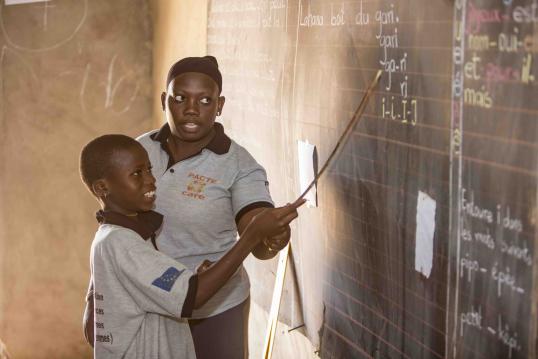Child labour is the consequence of a number of socio-economic factors. Situations of poverty and inequalities, the main causes of child labour, are often linked to a lack of social protection systems which help to face shocks and vulnerabilities. In the absence of accessible free quality education and decent work for adults and fair living wages, families cannot afford school fees for their children and are obliged to resort to cheap or free child labour.
According to latest ILO estimates, 160 million children across the world are in child labour. The consequences of the COVID-19 pandemic, conflicts and environmental crises threaten to reverse years of progress against child labour if no immediate measures are taken.
The EU’s role
The Sustainable Development Goals specifically target the ending child labour in all its forms by 2025 (SDG target 8.7) but the chances of reaching this target are looking less likely. For this reason, the EU has reaffirmed its engagement through a zero-tolerance policy on child labour and as a main global trade partner to tackle child labour in key global value chains with significant export to the EU.
The EU continuously works to address the root causes of child labour by tackling poverty, inequalities, increasing access to quality education and social protection, promoting due diligence for sustainable supply chains, and supporting partner governments, local actors and businesses, especially in the most affected countries.
2021 was the International Year for the Elimination of Child Labour organised by the International Labour Organization (ILO) and Alliance 8.7, and during which the EU, non-profit organisations, governments, private and public sector and many more stakeholders and individuals took action to act, inspire and scale up.
In May 2022, the 5th Global Conference on Child Labour led to a Call to Action in six areas to accelerate efforts and monitor progress to achieve SDG8.7 by 2025.
The EU Strategy on Child Rights 2021-2024 addresses child labour with important commitments to support free and easily accessible compulsory qualitative education, extending social welfare programmes, increasing capacity for partner countries’ labour inspection systems to monitor and enforce ILO Conventions to end child labour.
Child labour and the cotton sector
71% of child labour is in agriculture. Cotton is one of the most common commodities produced with child labour and forced labour in at least 18 countries in particular where cotton production systems are labour intensive in small-holder farms.
Through the CLEAR Cotton project, the EU is working with the ILO and FAO to eliminate child labour in all its forms in the cotton, textile and garment value chains in Burkina Faso, Mali, Pakistan and Peru. The project seeks to strengthen national legislation, policies and programmes to address the basic needs and rights of children. For example, the project is removing thousands of children from child labour to be reintegrated into school, older children in job training required by the labour market.

Children’s rights to education
More than one third of children in child labour are excluded from school and for those who do attend school, most struggle to balance their learning path with work, they generally do not attend school full time and are more likely to drop out prematurely.
Aligning minimum working age with compulsory schooling, registering children at birth, reinforcing countries’ social protection system, facilitating school-to-work transition and increasing back-to-school campaigns are among the many solutions for keeping children in school and out of child labour.
The EU is committed to dedicate 10% of the aid to partner countries in the education sector which will contribute to reducing child labour.

Child labour and gender equality
When women are educated, their children are less likely to be involved in child labour and hazardous work. By improving the literacy and numeracy skills of women, poverty, which is one of the main drivers of child labour, is reduced. Empowering women economically is another powerful means of reducing child labour.
When women can generate additional income, families can be lifted out of poverty and children are more likely to stay in school. Additional income also helps families better deal with shocks, such as the Covid-19 pandemic, and mitigate the need to rely on children for labour.
Raising awareness and building knowledge
EU funded projects also focus on raising awareness of communities, parents, teachers and businesses on the consequences of child labour and the benefits of investing in education. Through a participatory approach, children and families become actors in behaviour changes in communicating about the child labour consequences and the education advantages.
The stories of children in child labour, an animated video series
A series of short animated videos to shine a light on the different experiences of children in child labour. One animation depicts the life of Asha, a young girl working on her family cotton farm, another tells the story of Faustin, a young boy mining cobalt, and the final video is about Pitang, a girl who worked on a sugarcane plantation. The videos also show how the EU is helping remove children from child labour through its international partnerships .
